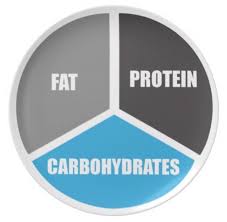
Six months ago I had no idea what a macronutrient was. The first thing that would have come to my mind would have been the macroeconomics course I took my freshman year of college in which my professor used trends in the purchase of beer among college students to demonstrate real-world examples of economic theory. This has nothing to do with macronutrients.
I first saw macronutrients as a measure on the foods I was eating in the MyFitnessPal app. I soon found out that I already knew the basic elements of macronutrients, just not what they were, exactly. In fact, even if you know nothing about nutrition, you more than likely already know all of the macronutrients by name. There are three macronutrients. We call them Carbohydrates, Protein, and Fat. See? That wasn’t so difficult.

However, in order to live a healthy lifestyle, it is not enough to simply know that they exist and what they are called. We need to dive a little deeper in order to attain true enlightenment on the importance of macronutrients, how they affect us everyday, and how we can manipulate them to achieve our health and fitness goals.
Let’s break it down. The Merriam-Webster dictionary defines a macronutrient as “a chemical element or substance that is essential in relatively large amounts to the growth and health of a living organism.” The only thing that tells us is that whatever a macronutrient is, we need it! How do we get them?
Every food that you eat is made up of macronutrients. Macronutrients are where your calories come from. If it has no macronutrients, it has no calories. If it has no calories, it’s probably not real food. (I’m looking at you diet soda.) The number of calories in your food is directly related to the grams of macronutrients in your food.
Every gram of carbohydrates in a food equates to 4 calories. For protein this is exactly the same (4 calories to one gram). Fat is the black sheep of the macronutrient family coming in at 9 calories per gram. Having a calorie density more than double that of carbs and protein per gram explains why many people say that fat…makes you fat.
Despite this high-calorie density, fat is not bad for you! Dietary fat is an essential component of keeping your body running properly. Without it, your bodily functions would not…function correctly and you would be feeling terrible. Fat helps your body absorb vitamins and slows digestion, making your last meal keep you feeling satiated longer. Yes, you do need to be aware so that you do not eat too much fat, but you cannot cut it out entirely.

Saturated fat is commonly referred to as the “bad” fat and is found in animal fats, butter, dairy, and coconuts. Monounsaturated and polyunsaturated fats are the “good” fats and help lower cholesterol, triglyceride levels, and blood pressure. Monounsaturated and polyunsaturated fats are found in olive oil, avocado, fish, and natural peanut butter. If you’re going to eat fat, make sure that most, if not all, of it comes from monounsaturated and polyunsaturated sources.
15%-25% of your daily calories from fat is generally considered safe. Don’t forget though, that one gram of fat is not equal to one gram of carbs or protein. If you eat a food that is 10 grams fat, 10 carbs, and 10 protein, your macronutrient ratio for that food is 23.5% carbs, 23.5% protein, 53% fat. So eat fat. Just keep it in check.
Let’s go back to carbohydrates. Carbs also get a bad rap, mostly because of the surge in popularity of low-carb diet plans. Again, they are ESSENTIAL and we cannot cut them out entirely. In fact, many people, especially athletes, are very healthy on high carb diets in which they eat 50%-60% or more of their daily calories in the form of carbs.

Put simply, carbs are the primary macronutrient in most foods that come from plants. Fruits, leafy and starchy vegetables, bread, pasta, rice, and all varieties of SUGAR are carbs.

Carbs act as quick and easily accessible fuel for your body. I read an article once that likened carbs to being “jet fuel” for your muscles. At any point that your body requires more fuel to create energy, the first place it will go is the carbs that your body has converted into and is storing as glycogen, then body fat and muscle mass.
Most people do pretty well with 40%-50% carbs. If you are trying to lose weight, you will probably want to bring carbs down to 30%-40%. A low-carb diet is considered to be anything below 30% carbs. It is dangerous to eat less that 10% of your daily calories from carbs, so don’t even mess with that nonsense. Eat carbs. They fuel your body.
The next macronutrient we need to look at is protein. Protein is, in my opinion, the most important, yet least eaten, macronutrient of the three. If you think that only gym bros care about protein intake, you are selling yourself short of the benefits of this awesome macronutrient! When you are looking at changing the macronutrients you are eating for a healthier lifestyle, this should be the first one you adjust. If you get the protein right, the others just kind of fall into place.

First of all, good protein contains all of the building blocks of muscle. When it comes to muscle, you’re either gaining or losing, so if you’re not eating enough protein (and supplementing with resistance training), you are losing muscle, and that is never good!
In order to keep muscle and be “in shape,” you should get no less than 25% of your daily calories from protein. When I started monitoring my macronutrient ratios, I was typically getting only 15%-20% of my calories from protein per day. I was not intentionally eating more carbs or fat, its just what happened from eating a typical American diet.
The truth here is that most people are really not eating enough protein daily, especially if they want to lose weight. When eating to lose weight, some sources recommend eating up to 50% of your calorie intake from protein! If you want to lose weight, exchanging carb calories for protein calories is a great way to lose faster. Not only does protein promote muscle growth, which increases metabolism, but protein also requires your body to spend more energy (calories) to process than it would for carbs.
Getting 25%-35% of your calories from protein is a good range. On an aggressive fat-loss plan, you will want to eat a 35%-45% protein diet. Eat protein. It is the stone that makes the temple that is your body.

Personally, I aim for a macronutrient ratio of 25% Fat, 40% Carbs and 35% Protein. I am on a fat-loss plan, but I’m not perfect. Most days I don’t even hit my protein goal. I am a work-in-progress and realize that eating 40% or more protein every day can be difficult feat! Even eating 25% protein per day is difficult if you are not monitoring your intake. Some days I don’t even hit that goal. So many of the foods available to us are high in Fat and Carbs. You cannot just one day decide “I am going start eating a 40% protein diet today!” You will probably fail. Maybe not right away, but unless you know what you are doing, it will be difficult to sustain for a long period of time. Instead, start by trying to hit my recommended minimum of 25% protein with 45% carbs and 30% fat. Once you feel like you can comfortably achieve this macronutrient ratio, try to increase your protein intake by 5% while decreasing either carbs or fat.
Be well,
Cory

